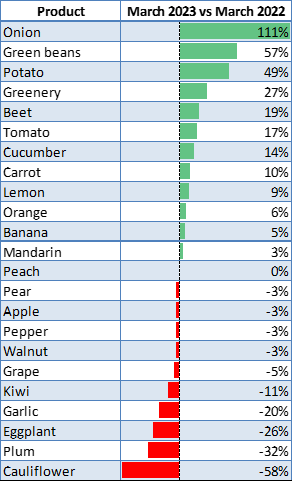EastFruit analysts highlight reduced inflation in Georgia. While we were used to seeing an annual difference of 10% or more in the general price level, or inflation, for quite some time now, the change in the overall price level in March 2023 amounted to only 5.3%. Alarmingly, a year-over-year change in the average price of the food group is still above 10%.

Data source: GeoStat
Month-over-month, the retail prices of all goods and services remained the same. So did the food prices. Halting of price growth usually happens at this time of the year, and such recent dynamics can be seen as a seasonal pattern. Will this grow into a trend? – nobody knows for sure, but as EastFruit has covered a number of times, local key players such as major banks, expect year-on-year average price growth for all goods and services, or the inflation, to gradually come down to the target of 3%. TBC Capital, a provider of investment, brokerage, research, and corporate finance solutions in Georgia, expects that to happen in July or even earlier.
Food prices, which grew by 12% compared to March 2022, had the highest positive impact on annual inflation. From the 5.3% growth of the general price level in year-over-year terms, 3.9% comes to the food group. The average retail price for fruits, nuts, and vegetables had the highest annual growth of 29% within the food group.
Annual price changes of fruits, nuts, and vegetables look followingly:

Data source: GeoStat. A discrepancy of 1% may occur in some cases due to rounding.
10 products out of 23 got cheaper than they were last year, but this was not enough to bring down the average price level of the group much. Products that got more expensive over the year are holding a significant share in Georgian consumer’s basket, thus they have a big impact on the group’s price as a whole.
We remind you that high retail prices in Georgia have multiple causes: increased local demand from the influx of Russian citizens, unfavorable weather resulting in an overall poor harvest of some key crops like potatoes in 2022, lasting high inflation in Turkey, and inflation imported from abroad. The latter is a very important piece of the puzzle, given that Georgia depends on imports, and this dependence is especially significant in 2023, given the first two factors on the list.
According to the Georgian government, importers getting very high markups could be an extra reason for food being expensive in Georgia. Research and action in this regard were announced in February. EastFruit will cover any updates on this initiative as they become public.
Interestingly, the discussed dynamics are not quite unique to Georgia. Annual inflation eased to 6.9% in March in the Eurozone, but the food prices there remained up by around 15%. One should also note that there were high inflation levels in Georgia for much more time than in the EU. Georgia has been experiencing quickly growing price levels since 2019, while the prices in the EU jumped amidst Russia’s unjust war against Ukraine and the energy crisis it caused.
The use of the site materials is free if there is a direct and open for search engines hyperlink to a specific publication of the East-Fruit.com website.




